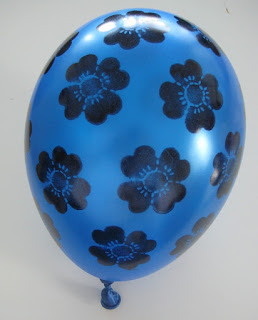Solarfast is a light-sensitive dye, which means that the colour develops when it is exposed to UV-light. You paint the dye onto fabric or paper, add some kind of resist that will block the light in certain areas, and then place it all in a sunny spot for about 10 minutes. During this time the exposed areas will react to the light and the colour will develop, whereas the areas in shadow will remain more or less unchanged, depending on how solid the resist is.
You could use objects and plants as resists, but I was interested in my own patterns and only used transparencies as resists. On one transparency I made a printout of one of my drawings with an inkjet printer - or in fact I made two printouts that I combined to make the dark areas more dense. The original drawing was a scanned line drawing, but I filled it with the bucket fill tool in my image-editing software.
On another transparency I drew a pattern with a black Posca paint pen. I'm sure other brands would work as well, but it is important that the ink is very solid, otherwise light will go through it.
On the last transparency I painted the same pattern but with black gesso and a brush.
According to the manufacturers instructions the dye has to be wet in order to work, but if it is too wet under a transparency there's a risk that condensation will form and interfere with the process. This is exactly what happened with my prints. Since I hadn't used the dye before it was impossible to know what is too wet, so I didn't worry too much about this. While developing the prints I could see condensation forming under the film, and how it would block the light in certain areas. But I could also see that this would not be a big issue for me, because the result was a beautiful mottled effect in a rusty brown colour. If you look closely at the images of the prints you will see brown (not fully developed) areas mixed in with the black (fully developed) areas. This is the result of condensation under the film. Here are the prints alongside the resists:
I really liked this process: it is simple, quick and has a lot of potential. Just imagine what you could do with photographs and scanned images of your own writing and drawings! The dye is ready to use (no more mixing toxic powders) and it comes in several different colours. I'm pretty sure this is a product I will return to again, because there is so much more to explore!
Thanks for visiting my blog and have fun printing in the sun!
























